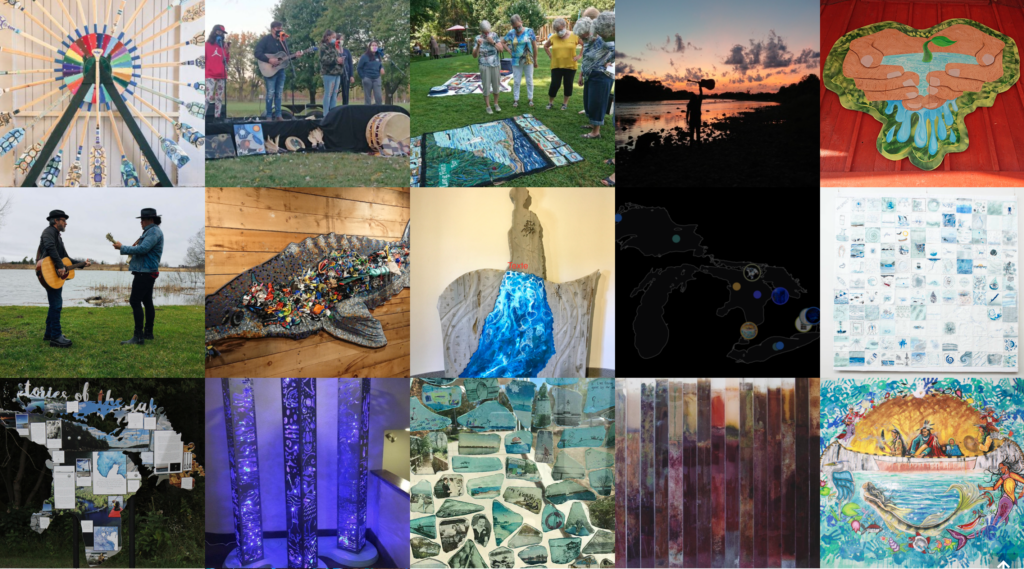Our Living Waters has decided to feature stories about member organizations’ use of art in their work, and to put a spotlight on the art and artists involved! This focus on “The Art of Water” aims to: highlight effective ways of driving change; honour the sacredness of water; and centre on right relations with Indigenous Peoples and waters in Canada.
Waterlution is an OLW Network member at the forefront of social innovation, focussing on artistic process as an approach to evolving our relationships with water. This Canadian non-profit works to build capacity, train young leaders, and lead the future of water. I recently spoke to Waterlution’s artistic director, Christopher McLeod. Christopher joined Waterlution in 2016 to work on the Great Art for Great Lakes project, and sees his work from the lens of an artist, educator, and researcher.

Empowering Youth to Connect with Water
In Christopher’s own words, Waterlution tries to “support people in finding and discovering their own connection to water”. He remarked to me that “this can happen in beautiful ways at so many different points in a person’s life”. Waterlution strives to connect with youth when they are forming thought patterns that lay a foundation for their future. As an organization, “Waterlution isn’t afraid to admit that we don’t always have solutions, and to question the status quo”. Christopher emphasized how important it is to ask if we have the right systems in place, with the right priorities, and the right level of care for ourselves and our neighbours. Young people can help ask these questions through the arts, finding empowerment and a strong voice.
If you are interested in learning about Waterlution’s current, arts-based, youth-focussed initiatives, listen to this recent podcast featuring the organization’s work in 2021. You can also read more about:
- À la rencontre du Fleuve (Call of the River) (French page only), a multidisciplinary set of school-based workshops and artistic engagement with the Quebec artist Alex Côté. If you live in Quebec, you’ll be able to see the installation in March 2022 at the Aquarium du Québec!
- Young Water Speaks, a national youth storytelling project with a travelling art exhibit, which you can view online here.
- Waterlution’s Co-Lab Challenge, where arts and science high school students from across Canada collaborate to answer tough questions, such as: “How do we convince decision makers that water management shouldn’t be based entirely on finances?”
Arts-based Knowledge Promotes Community
Christopher explained that Waterlution’s integration of the arts began both organically and intentionally. The organization had been working for a number of years on Water Innovation Labs (WILs), which are immersive leadership training opportunities to promote innovation and improve water security. The Waterlution team was always looking to broaden WILs’ impact, sustainability, and scalability. Over time, the team realized that integrating the arts evoked deeper, more intuitive ways of “knowing” from participants, especially when experiencing arts as part of a community. Arts-Based Community Development – artistic research supporting science and directly involving the public – can offer a way to bring artists and community members together to critically explore issues. And Waterlution really does this well, by working with professional artists on major water challenges.
During our conversation, Christopher recognized that people often think about learning and understanding, but that “knowing” is different. The arts can help us “know” about the world around us through intuition, embodiment, and spirit. For him, this idea of knowing has also expanded through his work with Indigenous communities. Currently, there is a more robust discussion in the water community about how Indigenous and western knowledge systems are different but complementary. For Christopher, arts-based knowledge is a way of knowing that has been able to expand relationships with Indigenous communities and develop better reciprocity between peoples.
I hope this story has helped expand your understanding of the arts and water. If you are feeling intrigued or excited about one of Waterlution’s art programs, please connect with Christopher McLeod.